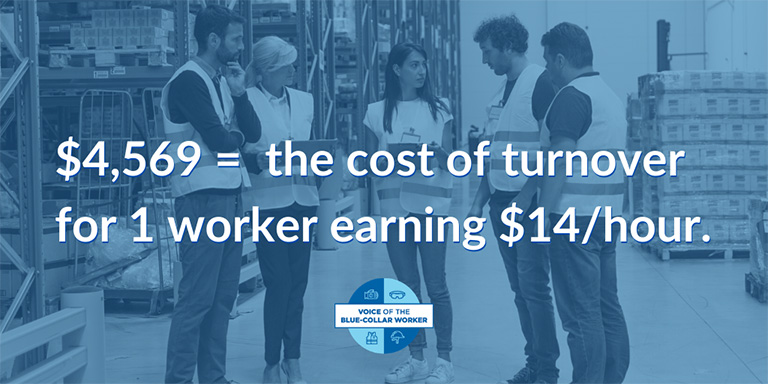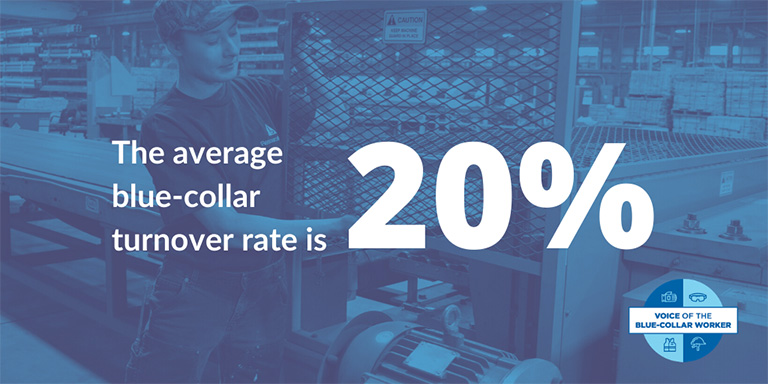What’s more effective than pay to retain blue-collar workers? Culture. Read what employers can do to reduce turnover & boost productivity.
By Cathi Canfield, Vice President, Associate Experience and Advancement
The demand for blue-collar jobs has grown steadily since the 2008 financial crisis and isn’t showing any signs of slowing down. The fact is there is high demand for blue-collar labor in the United States and simply not enough workers. It seems the blue-collar sector is now on par with many white-collar professions – where workers can opt to leave their jobs for more money and better work environments.
For many supply chain employers contending with a blue-collar unemployment rate that has dropped from 13 percent to 3.3% and an average turnover rate of 20%, the answer is to focus on more aggressive recruitment efforts – namely investing in more competitive wages. This is a smart approach when you consider that pay is the single biggest factor in blue-collar job acceptance, according to EmployBridge’s “Voice of the Blue-Collar Worker” survey.
But what if employers could help solve these challenges by reducing the number of workers they needed to replace due to turnover?
Staffing qualified people in the current labor market can be tough, even with competitive pay. And yet, all that effort won’t count for much if new hires start leaving prematurely. Today’s historically tight blue-collar labor market has elevated the need to retain workers already in place and identify ways to close the holes in talent pipelines. These days, companies must make an intentional effort to engage workers and reduce turnover.
Consider that the cost of losing just one blue-collar worker earning $14 hourly is $4,569, according to a meta-analysis by the Center for American Progress. That saving could be reinvested in efforts to help earn employee loyalty.
More than 18,000 blue-collar workers who participated in our “Voice of the Blue-Collar Worker” survey, indicated that their loyalty could be bought for a surprisingly low price – the existence of a worker-friendly, worker-focused culture. In fact, respondents named a “worker-friendly culture” as the top reason they would stay in a job. Meanwhile, pay lagged as the fourth reason.

It costs $4,569 to lose just one blue-collar worker earning $14 hourly, according to a meta-analysis by the Center for American Progress.
The power of workplace culture is often underestimated at corporations of all sizes and industries. Yet, culture determines the behavior and actions of corporate stakeholders and it goes beyond workplace policies and rules. It shapes what the company believes in, and most importantly, the values for which it stands.
However, in the supply chain sector, many employers unwillingly fall short of promoting a worker-friendly culture beyond the white-collar level. There is a growing divide between management and “desk workers” and the average blue-collar worker’s prevalent “us vs. them” mentality that can erode respect, trust, and dignity.
According to the EmployBridge’s recent “Associate Life Survey” findings, 68% of blue-collar, hourly workers say employees being treated equally is extremely important to a good work culture. Yet 40% of blue-collar workers agree that higher level employees at their company are shown more respect and honesty than hourly workers.
EmployBridge studies have identified what America’s blue-collar workers want and expect when it comes to workplace culture – which includes tactical policies and programs, as well as simple acts of kindness. Capstone Nutrition, a large manufacturer of nutrition products, is focused on just that.
“It’s a tough market and it’s important that people feel appreciated,” said Capstone Nustrition CEO Jared Leishman at a panel discussion. “It’s not about the dollars and cents for us, but it is about whether we are providing a great experience and appreciation for our associates. Culture, for us, is not about a yearly carnival or a poster on the wall. It’s about involving our employees in defining the company’s vision and goals and their role in those. Since we have instituted this philosophy, our total headcount is down 30% while our productivity skyrocketed 35%. It came down to focusing on what matters most to our associates.”

The answer to reducing turnover is more aggressive recruitment & retention efforts – namely investing in more competitive wages and culture.
For decades, leading companies have made a point of building a worker-friendly culture by taking purposeful steps to make people feel valued, appreciated, and part of the team. This effort can begin with something as simple as embracing the Golden Rule and treating blue-collar workers with the same dignity, respect, and simple kindness that is more commonly shown to white-collar workers.
In fact, 74% of respondents to our survey said, “being treated with respect or as a valued employee, not just a number” was extremely important to having a good work culture. Moreover, the top reason for staying with an employer came down to simple “honesty and respect” – trumping even benefits or schedule flexibility.
Being transparent and honest with your blue-collar workforce goes a long way in demonstrating your respect for them. Blue-collar workers, like all workers, want to be informed of major developments in the company’s financials, strategies, and policies. Even day-to-day transparency and communication play a large role in employee engagement and loyalty. For example, inform workers in advance that more overtime may be needed to meet production deadlines or that some shifts may not be needed during a projected slowdown. These simple, honest directives that allow them to make important life adjustments can mean more than you know to blue-collar workers who rely on every shift or paycheck to simply pay the rent or buy gas.
Showing respect and honesty at all levels of the organization is directly correlated with building a more loyal, highly-retained workforce.
Another key component of a worker-friendly culture is engaging with blue-collar workers more frequently, asking for input, and listening. When blue-collar workers were asked how their employer could get more “in touch” with them, the top method suggested was “ask us for suggestions,” followed by “visit or talk with us where we work.”
This means visiting the factory or warehouse floor more often, mingling with workers, understanding how they view their jobs, and getting to know them as people, not just as numbers. Ask your blue-collar workforce what they believe would engage them, and don’t just ask them once.
Asking is only the first step. Employers must listen and take action where appropriate based on employee feedback. When workers know their presence and feedback is valued, they feel they are “being heard.” More importantly, innovation doesn’t see the color of collar. You may be surprised to find that anyone – regardless of level – can deliver winning ideas and suggestions that can save your company money or time, or even drive revenue. Your blue-collar workers arguably know your product and processes the best.
“One of our top initiatives is to focus on employee experience,” explained Leischman. For example, one of the things we looked at is, ‘do employees have the tools they need to do their job.’ When we did that, we realized that we had about sixty-five picker/packers in our warehouse but we only had twenty-five scan guns. Half the workforce didn’t have the tool they needed to do their job. So, we ordered more.
Those sorts of things signal to employees that we are listening, and they feel heard. Then, they feel more empowered to say what they need to do their job and to provide us feedback. Today, when you walk into our facility you get a totally different vibe than four years ago. There is an energy level and everyone is excited and happy to be there.”
When is the last time you pulled up to a gas pump and didn’t fill up your car? Or, when did missing one day of work cause you to miss your rent or mortgage payment? For most blue-collar workers, getting gas means only buying four gallons at a time and missing a shift means missing rent payments.
For many employers, this perspective rarely comes into play when creating workplace policies or programs that are intended to engage or retain workers. In fact, 55% of blue-collar workers agree that their employer does not understand the daily financial or personal challenges they face. Common challenges that are relatively easy for higher-income earners to overcome can represent a crisis for a worker earning below the cost of living.
Consider more blue-collar friendly human resources (HR) policies and programs, such as the following:
As employers, we have an obligation to have empathy, not sympathy, but empathy – and create HR policies that are fair and that have the intended impact. The more you can help blue-collar workers get a fair shake, even improve their skills and quality of life, the better your operations will perform.
While white-collar jobs are performed at a more strategic level, blue-collar jobs are performed at the grass-roots level. To be more accurate, these workers do the job of putting your plans into action. While these employees may not hold advanced degrees, they are the foundation of your business. Your company needs loyal employees to be successful – regardless of the color of their collar.
In a tight unemployment market, if you don’t treat your employees well, you will be replacing them with workers of similar or lesser caliber and incurring the expense of recruiting, retraining, and time-to-production. However, when you succeed at building the kind of workplace that blue-collar workers want, you’ll reap the benefits – employees who are more motivated, perform better, act as brand ambassadors, and are more loyal.

Cathi Canfield
Cathi Canfield is the Vice President of Associate Experience and Advancement at EmployBridge where she focuses on improving the associate experience with each of the company’s brands. She partnered with Penn Foster to create Better WorkLife Academy, which provides free, skilled learning to EmployBridge associates who’ve attained over 40,000 skills to date. This is part of a larger Better WorkLife initiative she leads at the company to improve associates’ work lives through empathy, understanding, education and stability, which leads to higher engagement with customers. Before EmployBridge, she worked in economic development with regional economic development groups and utility companies attracting and growing new business.
Canfield holds a bachelor’s degree in Government from Smith College. She spends her free time with her young daughter traveling and being outdoors.
In this episode, I sat down with Beejan Giga, Director | Partner and Caleb Emerson, Senior Results Manager at Carpedia International. We discussed the insights behind their recent Industry Today article, “Thinking Three Moves Ahead” and together we explored how manufacturers can plan more strategically, align with their suppliers, and build the operational discipline needed to support intentional, sustainable growth. It was a conversation packed with practical perspectives on navigating a fast-changing industry landscape.